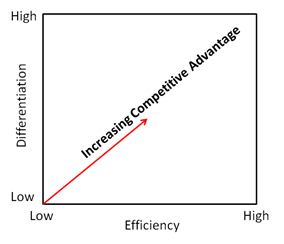Val Workman
The opinions expressed by the bloggers below and those providing comments are theirs alone, and do not necessarily reflect the opinions of Ryma Technology Solutions. As they say, you can't innovate without breaking a few eggs...
- Font size: Larger Smaller
- Hits: 28086
- 0 Comments
- Subscribe to this entry
- Bookmark
A Score Card for Product Management
The business intent of Product Management is to increase an organization's competitive advantage through various product initiatives. Competitive advantage is defined by product differentiation and process efficiency. An XY chart displays a competitive advantage score in terms of differentiation and process efficiency. This type of score card provides actionable information that a Product Management team can use for self-diagnostic in process improvement initiatives, and for performance comparisons between business quarters, or between different teams within the same organization. Standard charts enable comparisons across an industry.
You can use this score card as a sample. Create one table for each of the Seven Pillars. You will want to adjust the strategies to be in context of each pillar. Take the aggregated scores for each of the Pillars and combine them into one score for Differentiation. Computing a percentage achieved out of total possible will make your graphic representation easier to read and comparisons more meaningful.
|
Differentiation |
|||||
|
Business Goal |
Objectives |
Strategy |
Capability Metrics |
Target |
Score |
|
Market Sensing |
Formal Communication Channels Supporting Learning and Innovation |
Maintain a strategic and tactical communication plan between the market and Product Management Team |
|
|
|
|
Training, mentoring, and coaching activities defined by internal adoption plan |
|
|
|
||
|
Tightly Integrated Applications Supporting Culture and Process |
Application support for gathering and sharing assets, collaboration, and training. |
|
|
|
|
|
Process automation and standardization through common applications. |
|
|
|
||
|
Infrastructure Enabling Information Engineering and Processing |
Equal access to information used to create product management assets |
|
|
|
|
|
Ability to filter, sort, and analyze product management information |
|
|
|
||
|
Ability to gather, measure and monitor Pillar performance data |
|
|
|
||
|
Standardized Process & Language |
Common training , mentoring, and coaching across all team members. |
|
|
|
|
|
Common product management processes between business units |
|
|
|
||
|
Common applications supporting community of practice |
|
|
|
||
|
Common reports and performance metrics. |
|
|
|
||
|
Formalized Community of Practice |
Activities that provide access to new product knowledge |
|
|
|
|
|
Activities that develop the understanding of the new language associated with the new product concept |
|
|
|
||
|
Activities where active use of the new language for the purpose of knowledge and story sharing is provided |
|
|
|
||
|
Activities where learners are recognized as insiders within the community |
|
|
|
||
|
Activities that enable the creation of new product management knowledge |
|
|
|
||
|
Activities enabling the construction of new product concept language |
|
|
|
||
|
Activities enabling exploration, experimenting, and prototyping in the new concept |
|
|
|
||
|
Activities enabling the recognition and legitimization of new concepts within the community |
|
|
|
||
|
Project Management Planning, Execution, Monitoring, and Reporting |
Align market sensing activities in a common calendar including all major market facing events |
|
|
|
|
|
Coordinate market sensing activities with product release and product roadmaps |
|
|
|
||
|
Define market sensing activity dependency and sequences |
|
|
|
||
|
Establish market sensing activity estimates for duration, cost, risk, and resource needs |
|
|
|
||
|
Create resource plans |
|
|
|
||
|
Publish activity reports |
|
|
|
||
|
Portfolio Principle Based Decisions |
Identify and list alternatives that supports sorting, filtering, and portfolio segmentation analysis. |
|
|
|
|
|
Define selection criteria for alternatives |
|
|
|
||
|
Identify metrics used to measure selection criteria and rank alternatives |
|
|
|
||
|
Set portfolio thresholds for balancing |
|
|
|
||
|
Understand impacts of your decisions on resource availability and demand |
|
|
|
||
|
Aggregated Total Differentiation Score for Market Sensing |
|
||||
After you've completed the assessment in each Pillar you switch and take a look at process efficiency. We use the same Seven Pillars to establish business goals. The objectives of processes within each Pillar are listed at the end of this post for reference. Remove the ones not valid for your organization. For each remaining objective, you'll need to identify specific strategies your team is performing to accomplish the specific objective.
At this point your ready to identify metrics and conduct the self assessment of process efficiency.
|
Efficiency |
|||||
|
Business Goal |
Objectives |
Strategy |
Performance Metrics |
Target |
Score |
|
Market Sensing |
Market sensing thru market analysis methods
|
Identify specific activities used to accomplish these objectives, if any. |
Throughput, Latency, Quantity, Asset Turnover |
|
|
|
Example: Customer visits |
|
|
|
||
|
Market sensing thru competitive analysis methods |
|
|
|
|
|
|
|
|
|
|
||
|
Market sensing thru customer satisfaction methods |
|
|
|
|
|
|
|
|
|
|
||
|
Market evidence selection thru consensus & voting methods |
|
|
|
|
|
|
|
|
|
|
||
|
Market evidence selection thru Analytical Scoring & Portfolio Balance Methods |
|
|
|
|
|
|
|
|
|
|
||
|
Market evidence selection thru Qualitative Assessment Methods |
|
|
|
|
|
|
|
|
|
|
||
|
Aggregated Total Efficiency Score for Market Sensing |
|
||||
Aggregate your scores as you did for Differentiation. When you have your percentage, take it and subtract it from 1. This converts a high score, which is bad in performance, into a low Efficiency score. When you're done you'll have two scores, one for Differentiation and one for Efficiency. We map these on an XY diagram as shown here.
You can use this diagram to compare snap shots of your team's product management over time, or at one time compare different teams within the same organization. The closer you are in the upper right quadrant, the better your Product Management Team is doing.

Efficiency Objectives
Market Sensing
- Market sensing through market analysis methods
- Market sensing through competitive analysis methods
- Market sensing through customer satisfaction methods
- Market input selection through consensus & voting methods
- Market input selection through analytical scoring & portfolio balance methods
- Market input selection through qualitative assessment methods
Problem Definition
- Conceptualization methods used for problem definition
- Analysis methods used for problem definition
- Refinement methods used for problem definition
- Target market sampling methods used for problem validation
- Deductive reasoning and test methods used for problem validation
- Expert opinion methods used for problem validation
Opportunity Definition
- Conceptualization methods used for opportunity definition
- Analysis methods used for opportunity definition
- Refinement methods used for opportunity definition
- Tracing methods used for strategic alignment
- Scoring methods used for strategic alignment
- Decomposition methods used for strategic alignment
- Direct and proxy approval methods used for buyer-gate management
- Analytical scoring & portfolio balance methods used for buyer-gate management
- Modeling and forecasting methods used for buyer-gate management
- Consensus & voting methods used for opportunity selection
- Analytical scoring & portfolio balance methods used for opportunity selection
- Qualitative assessment methods used for opportunity selection
Feature Definition
- Conceptualization methods used for feature definition
- Refinement methods used for feature definition
- Analysis methods used for feature definition
- Target market sampling methods used for feature validation
- Deductive reasoning and test methods used for problem validation
- Expert opinion methods used for problem validation
Roadmap Definition
- Conceptualization methods used for roadmap definition
- Refinement methods used for roadmap definition
- Analysis methods used for roadmap definition
- Direct and proxy approval methods used for buyer-constraint management
- Analytical scoring & portfolio balance methods used for buyer-constraint management
- Modeling and forecasting methods used for buyer-constraint management
- Demand driven methods used for resource planning
- Resource Driven Methods used for resource planning
- Portfolio Driven Methods used for resource planning
- Consensus & voting methods used for roadmap selection
- Analytical scoring & portfolio balance methods used for roadmap selection
- Qualitative assessment methods used for roadmap selection
Requirement Definition
- Conceptualization methods used for requirement definition
- Analysis methods used for requirement definition
- Refinement methods used for requirement definition
- Target market sampling methods used for requirement validation
- Deductive reasoning and test methods used for requirement validation
- Expert opinion methods used for requirement validation
- Expert opinion methods used for requirement estimation
- Modeling methods used for requirement estimation
- Historical comparison methods used for requirement estimation
Launch Definition
- Conceptualization methods used for launch definition
- Refinement methods used for launch definition
- Analysis methods used for launch definition
- Target market sampling methods used for launch validation
- Deductive reasoning and test methods used for problem validation
- Expert opinion methods used for problem validation
- On-Demand methods used for launch execution
- Calendar paced methods used for launch execution
- Milestone paced methods used for launch execution








